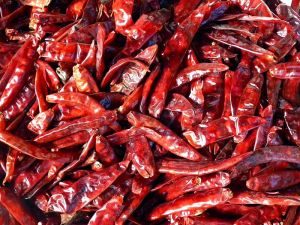
Central-east Mexico gave birth to the domesticated chili pepper — now the world’s most widely grown spice crop — reports an international team of researchers, led by a plant scientist at the University of California, Davis.
Results from the four-pronged investigation — based on linguistic and ecological evidence as well as the more traditional archaeological and genetic data — suggest a regional, rather than a geographically specific, birthplace for the domesticated chili pepper. That region, extending from southern Puebla and northern Oaxaca to southeastern Veracruz, is further south than was previously thought, the researchers found.
The region also is different from areas of origin that have been suggested for common bean and corn, which were presumably domesticated in Western Mexico.
The study findings are published online on April 21 in the Proceedings of the National Academy of Sciences, as part of a series of research papers on plant and animal domestication.
Crop domestication, the process of selectively breeding a wild plant or animal species, is of increasing interest to scientists.
“Identifying the origin of the chili pepper is not just an academic exercise,” said UC Davis plant scientist Paul Gepts, the study’s senior author. “By tracing back the ancestry of any domesticated plant, we can better understand the genetic evolution of that species and the origin of agriculture — a major step in human evolution in different regions of the world,” he said.
“This information, in turn, better equips us to develop sound genetic conservation programs and increases the efficiency of breeding programs, which will be critically important as we work to deal with climate change and provide food for a rapidly increasing global population,” Gepts added.
Study co-author Gary P. Nabhan, an ethnobiologist and agroecologist at the University of Arizona’s Southwest Center noted: “This is the first research ever to integrate multiple lines of evidence in attempts to pinpoint where, when, under what ecological conditions, and by whom a major global spice plant was domesticated.
“In fact, this may be the only crop-origins research to have ever predicted the probable first cultivators of one of the world’s most important food crops,” Nabhan said.
To determine crop origins, scientists have traditionally studied the plants’ genetic makeup in geographic areas where they have observed high diversity among the crop’s wild ancestors. More recently, they have also examined archaeological remains of plants, including pollen, starch grains and even mineralized plant secretions.
For this chili pepper study, the researchers used these two traditional approaches but also considered historical languages, looking for the earliest linguistic evidence that a cultivated chili pepper existed.
They also developed a model for the distribution of related plant species, to predict the areas most environmentally suitable for the chili pepper and its wild ancestors.
The genetic evidence seemed to point more to northeastern Mexico as the chili pepper’s area of domestication; however there was collectively more evidence from all four lines of study supporting the central-east region as the area of origin.
Source: Edited from a University of California Press Release, Contact Keith Sterling at [email protected]
Cover Photo, Top Left: Dried Chili Peppers RameshNG, Wikimedia Commons
_______________________________
Read about the most fascinating discoveries with a premium subscription to Popular Archaeology Magazine. Find out what Popular Archaeology Magazine is all about. AND MORE:
On the go? Purchase the mobile version of the current issue of Popular Archaeology Magazine here for only $2.99.
Popular Archaeology’s annual Discovery Edition eBook is a selection of the best stories published in Popular Archaeology Magazine in past issues, with an emphasis on some of the most significant, groundbreaking, or fascinating discoveries in the fields of archaeology and paleoanthropology and related fields. At least some of the articles have been updated or revised specifically for the Discovery edition. We can confidently say that there is no other single issue of an archaeology-related magazine, paper print or online, that contains as much major feature article content as this one. The latest issue, volume 2, has just been released. Go to the Discovery edition page for more information.






